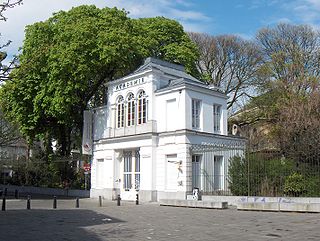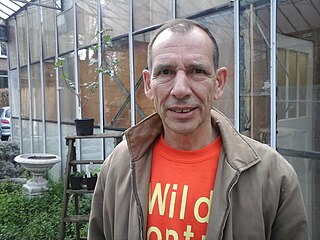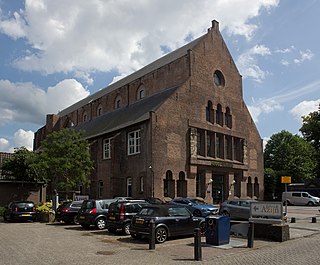
The Royal Academy of Art is an art and design academy in The Hague. Succeeding the Haagsche Teeken-Academie, the academy was founded on 29 September 1682, making it the oldest in the Netherlands and one of the oldest in the world. The academy has been the training ground for a number of significant artists of the Hague School. It was part of the art movement of Dutch Impressionism and in the immediate vicinity of the II. Golden Age of Dutch painting. In the 19th century, however, training was still strongly oriented towards the classic curriculum. At the end of the 19th century, the academy had opened to Modernism, too.

The Royal Academy of Fine Arts Antwerp is an art academy located in Antwerp, Belgium. It is one of the oldest of its kind in Europe. It was founded in 1663 by David Teniers the Younger, painter to the Archduke Leopold Wilhelm and Don Juan of Austria. Teniers was master of the Guild of St Luke—which embraced arts and some handicrafts—and petitioned Philip IV of Spain, then master of the Spanish Netherlands, to grant a royal charter to establish a Fine Arts Academy in Antwerp. It houses the Antwerp Fashion Academy.

The Royal Academy of Fine Arts of Brussels, is an art school established in Brussels, Belgium. It was founded in 1711. Starting from modest beginnings in a single room in Brussels' Town Hall, it has since 1876 been operating from a former convent and orphanage in the Rue du Midi/Zuidstraat, which was converted by the architect Victor Jamaer. The school has played an important role in training important local artists.
Hermanus (Herman) Berserik was a Dutch painter and print maker. He was a member of the Pulchri Studio in The Hague. He studied art at that city's Royal Academy of Art, where his teachers included Willem Schrofer, Willem Jacob Rozendaal, and Rein Draijer.
The Royal Academy of Fine Arts of Ghent is an art school that is one of the oldest art schools in Belgium. It is now part of the Hogeschool Gent.

St. Joost School of Art and Design is a Dutch academy of art and design based in Breda and 's-Hertogenbosch. The school is part of Avans University of Applied Sciences with offices in Breda, 's-Hertogenbosch and Tilburg.

Huibert Marie Luns was a Dutch painter, sculptor and writer. He also designed book covers, posters and medals.

Museum Slager is an art museum in 's-Hertogenbosch, Netherlands, dedicated to the work of eight local painters from three generations of the Slager family. Behind the distinguished façade of the building there is a collection of paintings, drawings, engravings, watercolours and objects, all directly related to this family of painters. The museum is located at 8 Choorstraat, not far from St. John's Cathedral.

Het Noordbrabants Museum is an art museum in 's-Hertogenbosch, Netherlands.

Johanna Gerarda Theodora van Eybergen was a Dutch artist specializing in applied arts and design, notable for her Art Nouveau work on metal. She was the first and for a long time the only Duch woman artist working on design on metal.

Bernardus Stefanus Henricus (Ben) Zegers is a Dutch visual artist, active as a sculptor and installation artist, and teacher and coordinator at the Gerrit Rietveld Academy.

Marie Heijermans or Marie de Roode-Heijermans (1859-1937) was a Dutch painter.

The Big Arsenal, in Dutch: Groot Tuighuis, in 's-Hertogenbosch, Netherlands, is also known as Old St. James Church, or Oude Sint Jacobskerk. It is the former location of the Noordbrabants Museum. It now houses the municipal heritage department and its storage. It is open to visitors four days a week.

The City Gymnasium of 's-Hertogenbosch is a grammar school, which is known as a gymnasium in the Netherlands. It is the second oldest school of the Netherlands.

Antonius Johannes (Antoon) Derkinderen was a Dutch painter, Glass artist, Draftsman and designer of book covers.

Dominicus Franciscus du Bois was a Flemish artist and draughtsman. From 1826, he directed the Royal School for Applied and Visual arts in 's-Hertogenbosch.

Johanna Berhardina Midderigh-Bokhorst (1880–1972) was a Dutch illustrator.
Marthe Crick-Kuntziger (1891–1963) was a Belgian museum curator at the Royal Museums of Art and History, where she specialized in tapestries and was the author of a hundred publications in her field. She was awarded the five-yearly Edmond Marchal Prize of the Royal Academy of Science, Letters and Fine Arts of Belgium for 1933–1937.

C. R. Hermans (1805–1869) was a Dutch teacher, historian, and archaeologist specialized in the history of North-Brabant.

Karel Aubroeck was a Flemish expressionist sculptor and painter. He is best known for his monumental sculptures such as the equestrian statue of King Albert I in Nieuwpoort and the sculpture group of the Van Raemdonck brothers on the Yser Towers in Diksmuide.





















